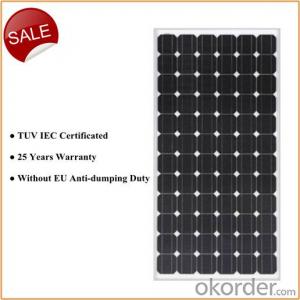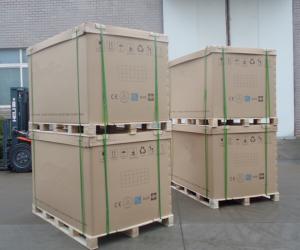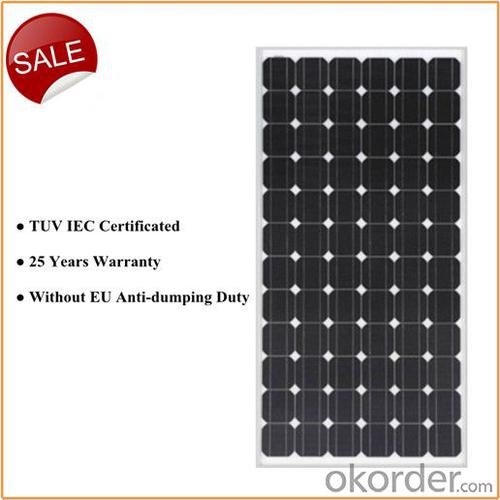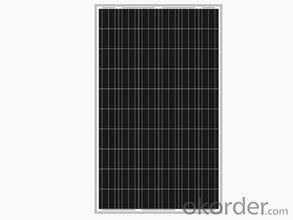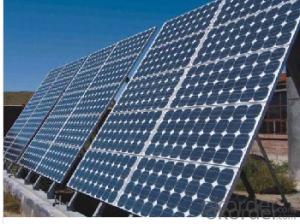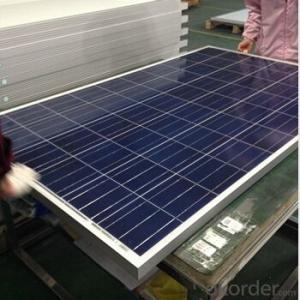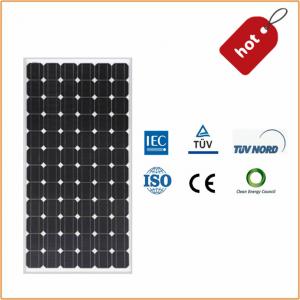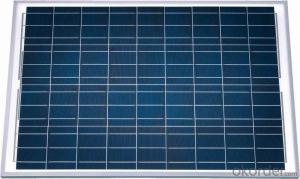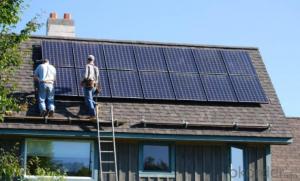Pool Solar Panels Near Me - Mono 305W PV Solar Panel with Certification TUV
- Loading Port:
- Ningbo
- Payment Terms:
- TT or LC
- Min Order Qty:
- -
- Supply Capability:
- 600MW Annual Year watt/month
OKorder Service Pledge
OKorder Financial Service
You Might Also Like
Prices for pv Solar Panels (305W Solar Module) with 310W Solar Panel Certification TUV
Mono 305w Panel Certificated with TUV,IEC,CEC,CE and so on.
Solar Panel Mechanical Characteristics
Cell Type | Mono Crystalline 156×156mm(6 inch) |
No. of Cells | 72(6×12) |
Dimension | 1956×992×50mm |
Weight | 23kg |
Solar Panel Component Element
Front Glass | 3.2mm, High Transmission, Low Iron, Tempered Glass |
Frame | Anodized Aluminum Alloy Type 6063-T5 |
Junction Box | IP 65 Rated (Black) |
Output Cables | TUV 1×4mm2, length:900mm |
Connector | MC4(UV resistance and self-locking/IP67) |
Encapsulation Material | EVA(0.50±0.03mm thickness) |
Back Foil | White TPT(0.32±0.03mm thickness) |
Fixing Adhesive | Silicone Sealant(White) |
Solar Panel Specifications
Module Type | NBJ-305M | ||||
Maximum Power at STC (Pmax) | 310Wp | ||||
Maximum Power Voltage (Vmp) | 36.60V | ||||
Maximum Power Current (Imp) | 8.33A | ||||
Open-circuit Voltage (Voc) | 44.00V | ||||
Short-circuit Current (Isc) | 8.91A | ||||
Module Efficiency (%) | 15.7% | ||||
Operating Temperature( °C ) | -40°C ~+90°C | ||||
Maximum System Voltage(V) | DC 1000V(TUV) / DC600V(UL) | ||||
Maximum Rated Current Series(A) | 15A | ||||
Power Tolerance | 0~+3% | ||||
Temperature Coefficients of Pmax | (-0.45±0.05)%/°C | ||||
Temperature Coefficients of Voc | (0.05±0.01) %/°C | ||||
Temperature Coefficients of Isc | (-0.35±0.02)%/°C | ||||
NOTC(°C ) | (47±2)°C | ||||
STC: Irradiance 1000W/M2 Module Temperature: 25°C AM=1.5
Solar Panel Warranty
Warranty | 10-year warranty on product material and processing technology |
Industry power output warranty: 90% in 12 years, 80% in 25 years |
Solar Panel Packing Configuration
Q’ty/Pallet, | 1×20’ft | 1×40’GP | 1×40’HQ |
Pallet Q’ty | 10pallets | 24pallets | 24pallets |
Q’ty/Container | 200pcs | 480pcs | 528pcs |
How the Solar Panel Works

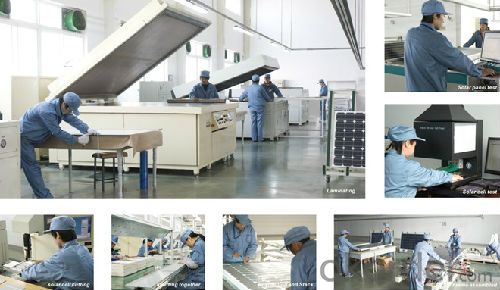
FAQ
I.Will you focus on the safety of the goods during transportation?
Yes, Safety of the cargo is the primary element that we would consider on transportation.
II..How would guarantee the quality will meet the requirements of your clients?
Before shipment, we will have inspection for each batch of goods.
III..What certificates do you have?
IEC,UL,TUV,CSA,etc.
IV..Can you do OEM according to clients’ requirements?
Yes, we have our own brand while we can provide OEM service.
- Q: do solar panels create electricity from the ultraviolet light created from the sun? because they only have an efficientcy of like 8% and this scientist found out a way to collect the visible light also, and he says the solar panel could have an effeciency of up to 80%! so my question really is, do solar penels creat electricity from heat? do you know of anything that can?
- Not many people realise it, but Einstein did not win the Nobel Prize for either Theory of Relativity. He was awarded the prize for his work on the photoelectric effect. i.e. the ability of some materials to take photons of light and turn their energy into electricity. Now, since most of the Sun's UV rays are filtered out by the Earth's atmosphere, else we'd be able to get a sunburn in seconds walking around outside in daylight, I think there is some energy imparted to the solar cells by UV wavelengths of light, but most solar cell materials rely on the wavelengths of electromagnetic radiation we call visible. Plus, I always thought infrared wavelengths conveyed more heat energy than UV rays.
- Q: Can solar panels be used to power a university?
- Yes, solar panels can be used to power a university. Solar energy is a renewable and clean source of power, making it an ideal solution for large institutions like universities. By installing solar panels on rooftops, parking lots, or open spaces, universities can generate a significant amount of electricity to meet their energy needs. Additionally, universities often have large campuses with ample space for solar panel installations, making it feasible to generate a substantial amount of solar power.
- Q: how fast does a 25watt solar panel generate power to a battery? trying to figure out a conversion factor here to get a rough estimate of how many i would need to power my house, please help?
- If your house already has utility power, then your best move is usually to stay connected to the utility even when you install solar. Then, there are no batteries involved. Also, you never need to worry about not having enough power on cloudy days or at night. During the day, the solar panels drive the electric meter backwards, building up a credit with the electric company. Then at night, the meter runs forward normally. What you end up with is a very small electric bill instead of no bill, but the net cost is a lot less than using batteries. As to how large a system or how much it will cost, you would call a professional to size your system and give a quote. You can always say no if the numbers don't work out.
- Q: Can solar panels be installed on flat surfaces?
- Yes, solar panels can be installed on flat surfaces. However, for optimal performance, it is recommended to tilt the panels at an angle that allows them to capture maximum sunlight.
- Q: How do I choose the right size of solar panels for my home?
- To choose the right size of solar panels for your home, you should consider factors such as your average electricity consumption, available roof space, and budget. Start by analyzing your energy usage over the past year to determine your average daily kilowatt-hour (kWh) consumption. Next, calculate the solar panel system size needed by dividing your average daily consumption by the average daily sunlight hours in your area. Additionally, assess your roof's orientation, shading, and structural capacity to determine the maximum number of panels it can accommodate. Finally, take your budget into account and consult with a professional solar installer to help you determine the appropriate size and type of solar panels that best meet your energy needs.
- Q: how the power output of solar panels fitted to a house can chargenothing on the internet really answers this question, any information will really help..this is for GCSE, i don't really understand the meaning of the question. does it ask how the solar panel egts charged, and how it works? i don't get how you can charge a solar panel and is heat the only way you can produce electricity for it??please answer if you know! much appreciated!!! thank you so so so so so so so much, in advance =)
- Solar panels do NOT get charged, so the question is junk, or you misstated it. Solar panels are used to charge a battery bank, which stores energy for times when there is no sun. Then energy from the batteries is used, via an inverter, to power appliances in the house. OR do you mean how the power output of solar panels can CHANGE? In that case, they change when the sun moves, such as behind a cloud, or just changes angle in the sky, or goes out.
- Q: Could anybody give some review about Homemade Solar Panel.
- If you want to make hot water then they are easy to make. Search the web.
- Q: Can solar panels be installed on a flat roof?
- Yes, solar panels can be installed on a flat roof. In fact, flat roofs are often considered ideal for solar panel installations due to their easy accessibility and potential for optimal sun exposure. Additionally, there are various mounting systems available that can be used to securely attach solar panels to flat roofs.
- Q: hey, Im going into my senior year at high school and after that will be moving to Pennsylvania where my family has a house on ten acres and I will be going to college there and living all year around. My father wants to build a huge barn for our cars and other stuff like tools, I mentioned too him what about solar panels on the roof to power maybe the house and barn. Would this be a good Idea? Where would be the best place to look into getting solar panels be? Thanks for anyones help!
- This is a site that can help you estimate the size and number of panels that will power what you intend to provide for. There are plenty of sites selling the panels, so compare prices. Also, check whether your state is offering the rebate like the state of CA is and what the restrictions, terms and conditions are. Even with the rebates they are very costly, so be certain to calculate the pay off period for your application to see whether it is a cost efficient option for your energy usage.
- Q: Why should I have a Generator if I have Solar Panels.....?
- Usually, a generator is more cost effective than a battery backup system for your solar panels. Most grid-tied solar arrays are connected to the grid without batteries. My company has installed well over 00 solar arrays for residential and commercial clients and almost none of them had battery systems with them. Many clients asked to see the costs and after that, they agreed that a generator seems better, especially if there is access to fuel readily available. Also, unless there is a battery system, the solar inverters will not operate when the electricity goes out. This is a safety feature, but it keeps you from using any power at all from the panels when the grid goes down. This explains the utility interactive solar inverters compared to the stand alone generators.
Send your message to us
Pool Solar Panels Near Me - Mono 305W PV Solar Panel with Certification TUV
- Loading Port:
- Ningbo
- Payment Terms:
- TT or LC
- Min Order Qty:
- -
- Supply Capability:
- 600MW Annual Year watt/month
OKorder Service Pledge
OKorder Financial Service
Similar products
Hot products
Hot Searches
Related keywords
